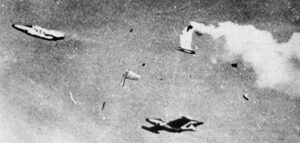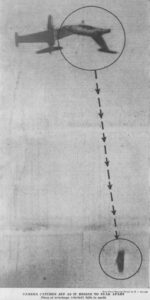“30 August 1952 -At 4:40 p.m., a tragic accident occurred during a fly-by of two new United States Air Force Northrop F-89C Scorpion all-weather interceptors at the International Aviation Exposition at Detroit, Michigan.

Two F-89Cs of the 27th Fighter-Interceptor Squadron, 4711th Defense Wing, based at Griffis Air Force Base, Rome, New York, made a low-altitude, high-speed pass in full view of 51,000 spectators, including General Hoyt S. Vandenberg, then serving his second term as Chief of Staff, United States Air Force. Suddenly, the left wing of the lead interceptor separated. The tail also broke

away and the fighter crashed and exploded. In the resulting fire, the Scorpion’s 20-millimeter cannon shells detonated.
A local newspaper reported:
The crash occurred 4:40 p.m., toward the end of the day’s show.
Adams and Richter were swooping down over the field in a “fly-by,” or speed run, Adams flying to one side and slightly to the rear of Recher.
Suddenly, Adams’ plane swerved to the right. A piece was seen to break off, then an instant later the right wing tore off.
As the pilot struggled to gain altitude, the left wing and tail section ripped off, and the hurtling fuselage continued across the field. It crashed between the railroad tracks and the Willow Run Expressway.
It ripped up tracks, fences and telephone lines. Heat from the burning wreck turned the rails cherry red.
Two passenger trains, eastbound and westbound, screeched to a halt to avoid piling into the wreckage. Railroad service was delayed an hour until tracks were repaired. . .
AIR FORCE OFFICIALS theorized that the crash was probably caused by turbulent air near the ground added to the stress put on the plane by the maneuver, plus the added thrust of the afterburners, devices which give added “push” to the jet.
Gen. Hoyt S. Vandenberg, Air Force chief of staff, said, “This is one of the strongest airplanes that has ever been built, but there are some things you just can’t build against.” —The Detroit Free Press, Sunday, 31 August 1952, Vol.122, No. 118, Page 4, Columns 2–3
Major Donald E. Adams, a fighter ace who had won the Silver Star in Korea just months earlier, was killed, along with Captain Edward F. Kelly, Jr., the radar intercept officer. Five people on the ground were injured by falling wreckage.
The second F-89 was flown by Major John Recher and Captain Thomas Myslicki. They landed immediately at Selfridge Air Force Base.
This was not the first wing failure in an F-89C, nor the last. The Air Force grounded the Scorpions and ordered Northrop to return the airplanes to the factory or to modification centers using the company’s pilots. Northrop engineers began an intensive investigation to discover the cause of these catastrophic failures.
When designing the airplane, engineers tried to use materials that provided the greatest strength at the lightest weight. A new aluminum alloy had been used for the wing attachment fittings. This material had properties that weren’t understood at the time, but when subjected to certain types of dynamic loads, it could fatigue and become brittle rapidly. It was also very sensitive to surface imperfections, such as scratches or machining marks, that could rapidly propagate fatigue fractures.
A second problem was that, under certain conditions, the Scorpion’s wings could enter a sequence of rapidly increasing oscillations, actually twisting the wing. This occurred so quickly that a pilot was not likely to see it happening. The twisting motion focused on the wing attachment points, and resulted in a catastrophic failure.
Northrop redesigned the wing to reduce the oscillation, and replaced the aluminum attachment fittings with new ones made of forged steel.
The F-89 was returned to service and became a very reliable airplane.”
Source: thisdayinaviation.com by Bryan R. Swopes c. 2018
